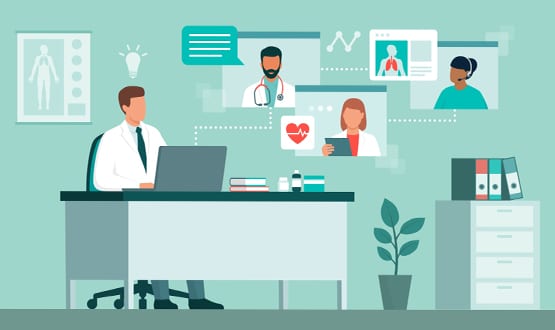Open your eyes
- 21 August 2012

In the cafeteria of Moorfields Eye Hospital, Bill Aylward flicks through an online patient record on his laptop and books the imaginary patient in for cataract surgery.
This functionality is the first phase of the trust’s open source electronic patient record project – Open Eyes – which has been live at the hospital since January.
The patient administration and booking system has been well received, he says, and he is looking forward to the addition of clinical modules in September. His goal is to turn the tables on the disparity between personal and work IT.
He no longer wants to hear clinicians in the café complaining about the IT in their surgeries while happily playing Angry Birds on their iPhones. Rather, he wants to hear them singing the praises of the technology available on the job.
A frustrated medical director
Aylward was medical director at Moorfields for eight years. In that time, he was constantly coming across questions that he could not answer, because of a lack of data.
It was this experience as a “frustrated medical director” that led to him to take on the EPR project. In early 2010, he stepped down from his medical director post, and the hospital allowed him to continue to dedicate four sessions a week to Open Eyes.
Meanwhile, Aylward’s experience with commercial providers drew him towards making the project open source. He says the potential loss of intellectual property is a risk with a commercial arrangement and clinicians are much more likely to contribute their ideas, energy and time if they get to use the result.
A little bit of history
In 1997, Moorfields began an EPR-pilot called ProMed. The system was developed in-house and involved clinicians directly inputting clinical data, as well as handling correspondence and e-prescribing.
In 2000, the system was handed over to a company called Target4, which agreed to develop it for nothing in return for sales elsewhere.
The new system, called ePatient, was rolled out across the hospital for two of its nine subspecialties and at one point had 60,000 clinical noting entries a year, representing about 20% of annual outpatient activity.
“We thought we had it cracked. In a couple of years we would have it all electronic and kiss paper notes goodbye,” Aylward says.
However, in 2003, usage started to drop. One of the problems was that changes in the user interface made data entry slower.
Previously a diagnosis could be entered with two clicks, but when additional clicks were added, the collection of diagnoses dropped to almost zero.
The programme was ultimately cancelled when sales elsewhere did not materialise; not least because trusts believed they would get a similar product for free from the National Programme for IT in the NHS. The system was bought by Stalis in 2006.
Show me the money
Moorfields agreed to fund an open source EPR to the tune of £3.5m over four years, but expects to save £4.5m over the same time.
In the open source environment, 40 ophthalmologists around the country come up with ideas and test functionality on a website once it is developed.
Back in the hospital cafeteria, icons on the left of Aylward’s screen indicate all past patient events, classified according to things like investigations or images, making it easier for clinicians to quickly find what they need.
Aylward explains that the idea was to replicate flicking through paper notes. The development team has returned to the popular “two-click diagnosis”, with a list of the most common diagnoses presented according to the specialty of the clinician logged-in.
This means the relevant diagnosis will be on the drop-down menu 90% of the time. A doctor can schedule an operation in the system while the patient is still in the room, allowing them to walk away with a print-out of their surgery time and date and instructions of what to do next.
Clinical functionality comes next
A major milestone will be reached when the first three clinical modules of the system go live in early September.
The first is an operation notes module, in which a clinician notes the procedure done -as pulled from the booking note – and is then asked for additional information.
Aylward explains that this was previously quite time consuming, as doctors had to draw a diagram and then write out an explanation of the surgery as well.
In the new system, a diagram is provided, which clinicians can easily manipulate. The description is created automatically from that. “The idea is to get all the information required but very very quickly,” he adds.
The second module is for prescriptions. Inputting data is made quicker because a standardised set of drugs that are usually prescribed after a specific operation are offered as a default which can then be modified.
The final module is correspondence and involves discharge letters being pre-populated with information such as the latest surgery and prescription and the post-operative review.
Aylward says the development of this functionality came from lessons learned with ePatient which also prepopulated letters, but would allow clinicians to send them when fields were not entered, leaving some to be addressed to “Dr unknown”.
“We made the automatic generation much more robust,” he explains.
The discharge forms are based on primary care trust specifications, so although they have not been live tested with GPs, Aylward feels confident they will be well-received.
In September, a clinical examination module will also be included to follow the status of a patient through an episode of care.
Aylward acknowledges that this requires different amounts of information to be input at different points of time so the team has kept mandatory fields to a minimum and allowed clinicians to add something different or unexpected if needed.
Another module being worked on allows clinicians to calculate an individual patient’s risk of cataract surgery according to their case and experience of the surgeon.
Who gets to use it?
As a web-based system, Open Eyes does not require any software to be installed and can run on any device. It also does not need to run on the NHS network, N3, which is crucial as it means it can potentially be opened up to optometrists who are not on the N3 network.
Most of the hospital’s referrals are from optometrists who use basic paper forms to refer. Aylward explains that if optometrists had access to the system, they could directly input the necessary patient information, which would allow a clinician to decide if an operation is needed before seeing the patient.
This means the patient could be booked in for an operation without having to set foot in the hospital and later discharged back to their optometrist to fill in post-operative details, saving a further hospital visit.
This idea, however, has stirred up concern amongst those responsible for information governance.
In response, the development team is going to pilot access with a small number of optometrists to check the security is sufficient then plans to write to the health secretary to ask for approval to run the system outside of N3.
An open future?
The plan for Moorfields is to go paper-lite by the end of next year. Aylward says benefits will be incremental until that “big realisation” is achieved.
“This is my third attempt at this and I’m happy we have got it [the EPR] right this time, having learnt lessons from the last two,” he says.
“The open source model has brought in clinicians by the droves and they are all saying the same thing – that this is the right approach.”
Interest in the system is high amongst other hospitals. However, of all the trusts the team has spoken to, only 10% have an IT department capable of deploying and supporting it.
“They are used to buying commercial software, they are not necessarily anti-open source, but they can’t support it,” Aylward says.
One answer to this would be the creation of a new entity being set up specifically to install and support the software.
“That would be a commercial entity and I’m very keen on keeping it separate because the people contributing to this are contributing because it’s an open source project so that must be preserved.”




